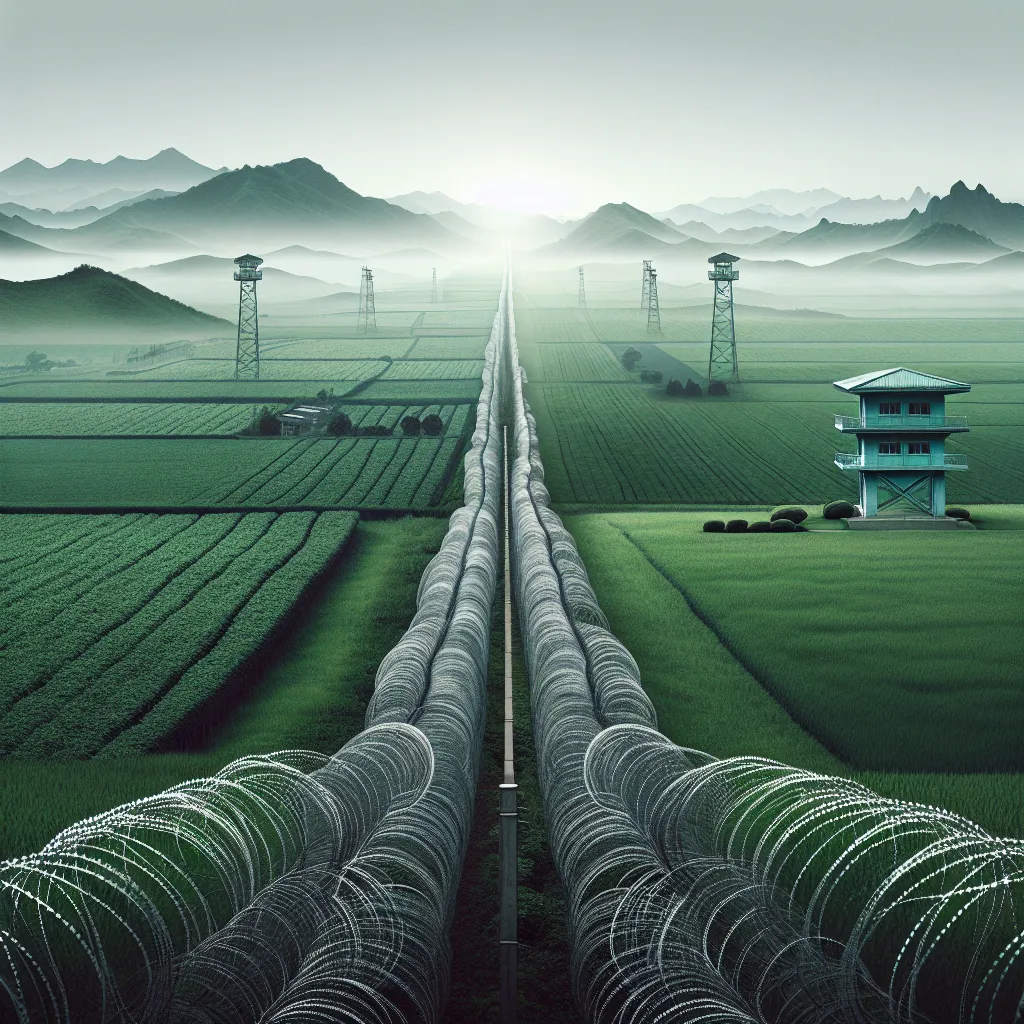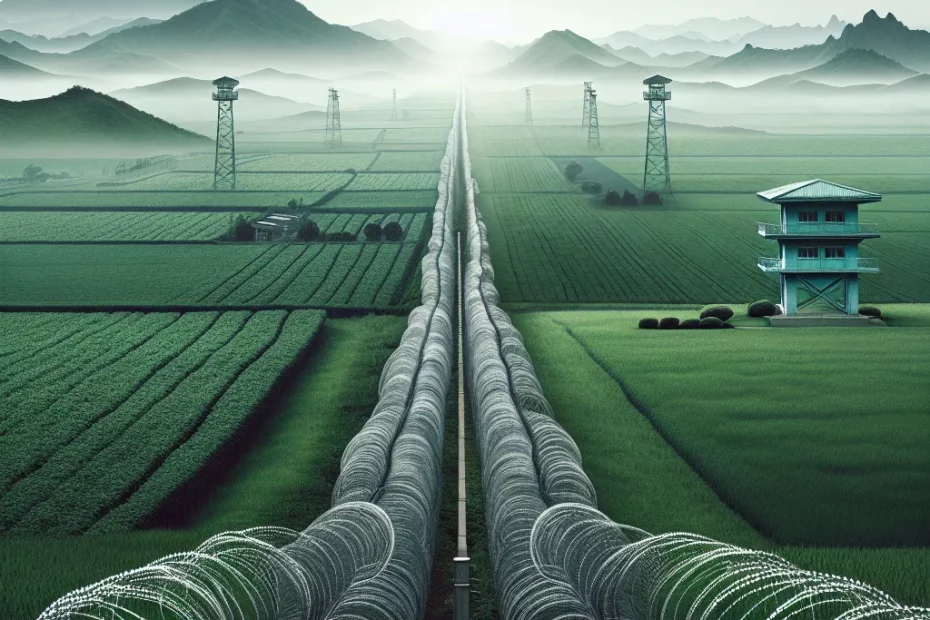The Demilitarized Zone (DMZ) that separates North and South Korea stands as a stark reminder of the divided history of the Korean Peninsula. This physical barrier, laden with historical significance, not only symbolizes the enduring tensions between the two Koreas but also serves as a testament to the complex web of global politics that have shaped the region. As we delve into the intricate layers of Korea’s past, we begin to unravel the profound impact that the DMZ has had on the nation’s identity and its place in the world. In this blog post, we will explore the multifaceted dimensions of the DMZ, from its historical roots to its contemporary implications, shedding light on its role in shaping the narrative of Korea’s past, present, and future.

The Demilitarized Zone: A Physical Barrier Between North and South Korea
In the heart of the Korean Peninsula lies a stark reminder of the division that has plagued the region for decades – the Demilitarized Zone (DMZ). Stretching 250 kilometers long and 4 kilometers wide, this heavily fortified strip of land serves as a physical barrier between North and South Korea, symbolizing the deep-rooted tensions and conflicts that have defined the two nations.
The Establishment of the DMZ
The DMZ was established in 1953 as part of the armistice agreement that ended the Korean War, creating a buffer zone to prevent further hostilities between the two sides. Despite its name, the DMZ is one of the most heavily militarized borders in the world, with troops from both North and South Korea stationed along its perimeter.
The Living Testimony of Division
The DMZ is not just a line on a map; it is a living, breathing testament to the division of the Korean Peninsula. Landmines, barbed wire fences, and guard posts dot the landscape, serving as constant reminders of the fragile peace that exists between the two Koreas.
Ecological Value of the DMZ
Despite its militarized nature, the DMZ also holds significant ecological value. The area has become a haven for wildlife, with endangered species finding refuge in the absence of human interference. Efforts are being made to preserve the natural beauty of the DMZ, highlighting the potential for peace and reconciliation in the region.
Complex Geopolitical Dynamics
The DMZ is not just a physical barrier; it is a microcosm of the complex geopolitical dynamics at play in the Korean Peninsula. It is a place where history, politics, and ideology converge, shaping the destiny of millions of people on both sides of the border.
Symbol of Division, Conflict, and Hope
As tensions continue to simmer between North and South Korea, the DMZ stands as a stark reminder of the challenges that lie ahead in achieving lasting peace and reunification. It is a place where the past meets the present, and where the future of the Korean Peninsula hangs in the balance.
In conclusion, the Demilitarized Zone is more than just a physical barrier; it is a symbol of the division, conflict, and hope that define the relationship between North and South Korea. As we look to the future, the DMZ serves as a reminder of the importance of dialogue, diplomacy, and cooperation in overcoming the legacy of the past and building a brighter tomorrow for all Koreans.
Historical Context: Events That Led to the Creation of the DMZ
In understanding the significance of the Demilitarized Zone (DMZ) that divides North and South Korea, it is crucial to delve into the historical events that culminated in its establishment. The Korean War, which lasted from 1950 to 1953, left the Korean Peninsula in ruins, with millions of lives lost and families torn apart. The Armistice Agreement signed on July 27, 1953, effectively halted the fighting and established the DMZ as a buffer zone between the two Koreas.
The Establishment of the DMZ
The DMZ stretches 250 kilometers long and 4 kilometers wide, encompassing a variety of terrains ranging from lush forests to minefields. It serves as a stark reminder of the unresolved conflict between North and South Korea, frozen in time since the armistice was signed. The area is heavily fortified, with barbed wire fences, guard posts, and landmines scattered throughout, symbolizing the tense and fragile peace that exists on the peninsula.
One of the most infamous incidents that highlighted the volatility of the DMZ occurred in 1976 with the Axe Murder Incident. Two United States Army officers were killed by North Korean soldiers while attempting to trim a poplar tree in the Joint Security Area. This brutal act of aggression heightened tensions on the peninsula and underscored the potential for conflict to escalate within the DMZ.
Over the years, the DMZ has become a unique ecological haven, with diverse flora and fauna thriving in the absence of human interference. It has also become a symbol of hope for reunification, with various peace initiatives and diplomatic efforts aimed at easing tensions and fostering dialogue between the two Koreas.
Despite its significance as a historical landmark and a testament to the divided history of Korea, the DMZ remains a poignant reminder of the ongoing division and conflict that persists on the Korean Peninsula. As the world watches closely, the DMZ stands as a tangible representation of the complexities and challenges involved in achieving lasting peace and reconciliation in the region.
The DMZ, with its complex history and geopolitical implications, continues to be a focal point for discussions on Korean reunification and global security. Its existence serves as a constant reminder of the need for diplomacy, dialogue, and cooperation in resolving conflicts and building a more peaceful world for future generations.
International Relations: Influence of the DMZ on Global Politics
The Demilitarized Zone (DMZ) that separates North and South Korea stands as a stark reminder of the division that has plagued the Korean Peninsula for decades. This 250-kilometer long and 4-kilometer wide buffer zone is not just a physical barrier but also a symbol of the geopolitical tensions that have defined international relations in East Asia.
The Significance of the DMZ
The DMZ holds immense significance in global politics, serving as a microcosm of the broader power struggles and diplomatic intricacies that shape the world order. With both North Korea and South Korea heavily militarized along the border, the DMZ has become a focal point for international attention and concern.
Historic Summits and Global Security
In recent years, the DMZ has been the site of historic summits between world leaders, including the unprecedented meeting between North Korean leader Kim Jong-un and South Korean President Moon Jae-in in 2018. This meeting, which took place at the Peace House in the border village of Panmunjom, captured the world’s imagination and raised hopes for a peaceful resolution to the longstanding conflict on the Korean Peninsula.
Furthermore, the DMZ plays a crucial role in the broader context of global security. The presence of nearly two million troops on both sides of the border, coupled with North Korea’s nuclear capabilities, has made the DMZ a potential flashpoint for conflict with far-reaching implications. The international community closely monitors developments in the region, acutely aware of the potential for escalation and the need for diplomatic solutions.
Legacy of the Cold War and Global Challenges
Moreover, the DMZ serves as a reminder of the enduring legacy of the Cold War, with the division of Korea mirroring the broader ideological and geopolitical divisions that characterized the 20th century. As tensions between major powers continue to simmer, the DMZ stands as a poignant symbol of the need for dialogue, cooperation, and conflict resolution in the face of global challenges.
Conclusion
In conclusion, the DMZ’s influence on global politics cannot be overstated. As a symbol of division and reconciliation, conflict and cooperation, the DMZ encapsulates the complexities of international relations in the modern era. It serves as a reminder of the fragility of peace and the imperative of diplomatic engagement in resolving conflicts that have far-reaching consequences for the world at large.
Impact on Korean Society: How the DMZ Shapes National Identity
The Demilitarized Zone (DMZ) that divides North and South Korea is not just a physical barrier; it is a symbolic representation of the deep-rooted division that has shaped the national identity of both countries. Spanning approximately 250 kilometers in length and 4 kilometers in width, the DMZ is a stark reminder of the Korean War that ended in an armistice, not a peace treaty. 🕊️
The Psychological Barrier
One of the most significant impacts of the DMZ on Korean society is the psychological barrier it creates between the two Koreas. For decades, the DMZ has served as a constant reminder of the unresolved conflict and the separation of families. The presence of heavily armed soldiers on both sides of the border perpetuates a sense of tension and unease, reinforcing the idea of a divided nation. ☮️
Symbol of Hope for Reunification
Moreover, the DMZ has become a symbol of hope for reunification among the Korean people. Despite the physical barrier, the DMZ has also been a site of various peace initiatives and diplomatic efforts to ease tensions between the two Koreas. The recent summits between North and South Korean leaders at the DMZ have raised hopes for a peaceful resolution to the longstanding conflict. 🤝
Cultural and Historical Narratives
The DMZ also plays a crucial role in shaping the cultural and historical narratives of both North and South Korea. In South Korea, the DMZ has become a popular tourist destination, attracting visitors who seek to understand the country’s tumultuous past and the ongoing efforts for peace. On the other hand, in North Korea, the DMZ is often portrayed as a symbol of resistance against external threats, reinforcing the regime’s narrative of self-reliance and strength. 🌏
Environmental Impact
Furthermore, the environmental impact of the DMZ cannot be overlooked. Due to its restricted access and limited human presence, the area has become a unique ecological habitat, serving as a sanctuary for various endangered species. Efforts to preserve the natural biodiversity of the DMZ have gained international recognition, highlighting the importance of maintaining peace for the sake of both humanity and the environment. 🌿
In conclusion, the DMZ is not just a physical boundary; it is a complex symbol that shapes the national identity of both North and South Korea. As efforts for peace and reconciliation continue, the significance of the DMZ in Korean society will remain a poignant reminder of the challenges and aspirations for a unified Korea. 🇰🇷🕊️
The Demilitarized Zone (DMZ) stands as a powerful symbol of the division between North and South Korea, encapsulating a tumultuous history of conflict and tension. As a physical barrier, it not only separates the two countries but also serves as a reminder of the ongoing geopolitical complexities in the region. The events that led to the creation of the DMZ are deeply rooted in the Korean War and the subsequent armistice agreement. This historical context highlights the enduring impact of past decisions on the present situation. In terms of international relations, the DMZ plays a crucial role in shaping global politics, with major powers closely monitoring developments in the area. Within Korean society, the DMZ influences national identity, serving as a constant reminder of the divided past and the aspirations for reunification. Its significance cannot be understated, as it continues to shape the dynamics of the Korean Peninsula and beyond.
